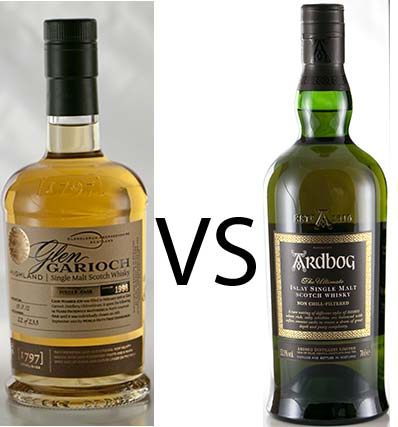
Age vs non-age statement (NAS)
Since a couple of years ago, Glenmorangie removed the age statement from most of their single malts, Johnnie Walker Platinum lost its age statement recently, as did Macallan or Bruichladdich for their core range, to cite only a few of them.
 |
| Two different (and extreme) approaches: From an exhaustive indication (left: age, distillation and bottling date, cask number, etc) to a minimalist approach (right: abv and name) |
Does it matter? Yes and no.
Why?
For most brand leaders, sales are exceeding the forecasts made 5 to 10 years ago and companies such as Edrington (Macallan, Highland Park) or Diageo (Johnnie Walker) are running low on stock of aged products. In order to maintain the sales momentum, you need to keep producing the product in a consistent way, at least for the core products.
Not only the big players are suffering from their success, but independent distilleries or recently opened/built distillery as well.
By removing the age statement, you have more flexibility to maintain your consistency as well as for your cask (stock) management, since this might allow you to draw whisky from any cask, regardless of its age. For a financial point of view it is interesting as well, since you can reduce the age of the whisky, and thus reducing your costs, while maintaining the price (and increasing your margin as well).
In the end, as a consumer, I care mainly about the quality of the product.
If the product is 10 or 12 years old and taste good, then the age statement does not really matter to me.
For some premium whiskies you might want to mix together some very old rich and complex malts with younger whiskies to give more balance and flavour intensity to the final product.
Where I do not really agree, is when companies remove the age statement to reduce the age of the product while keeping the price at the same level. Unfortunately, this practise seems to occur rather frequently.
In conclusion, as a consumer, my main concern is the quality of the final product and a price in accordance to it, but I am not ready to pay over £150 for a 5 years old product either. I want to know what I am paying for.
A good example on transparency about non-age statement is the Balvenie Tun 1401, where you know the age of each cask used for the vatting. Companies do not need to go to that level of detail, but transparency is required. The consumer should need to know what he/she is paying for.
If producers do not want to have an age statement on their bottles, e.g., for administrative reasons (you do not want to change your label with every batch, especially for a product sold in the US), they could at least add a little booklet or provide a link to a webpage associating the lot number and details on its composition?
What do you think?
Slainthe
Patrick
Patrick 17 Dec 2013.